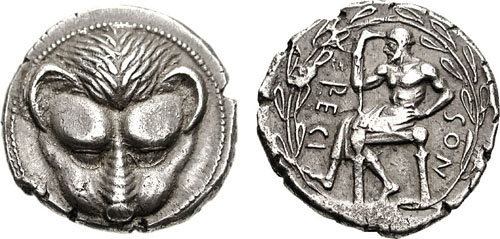
The seated figure on the reverse of the early coins of Rhegion is shown either as a muscular young man or a mature bearded figure. He holds a staff and either a phiale or kantharos. Adjunct symbols are the dog, serpent, duck, crow, and grapes. He was first identified as Iokastos, the oikistes (founder) of Rhegion, by J.P. Six in NC (1898), pp. 281-285. Prior to that, the most popular candidate was Aristaios or Agreus, son of Apollo and Kyrene (cf. Head, HN). Iokastos was one of six sons of Aiolos, ruler of the Aeolian islands, all of whom sÉcured their own realms in Italy and Sicily. Iokastos held the region around Rhegion and died of a snakebite. Aristaios, born in Libya, discovered the silphium plant, and was the patron of beekeepers (mentioned by Virgil), shepherds, vintners and olive growers. He also protected Dionysos as a child, and was the lover of Eurydike, who died of a snakebite. While Iokastos has direct connections with Rhegion, the subsidiary imagery of youth and old age, kantharos, grapes, dog, and crow all point to a Dionysiac figure. The serpent seems to play a role in both legends. The direct and indirect connections between Aristaios and Dionysos-Bacchus possibly indicate the existence of a cult of Aristaios at Rhegion. Note also the prominence of Apollo, father of Aristaeos, on later coins of Rhegion.
BRUTTIUM, Rhegion. Circa 450-445 BC. AR Tetradrachm (17.28 g, 10h). Facing lion's head / RECI-NOS, Iokastos seated left holding staff in right hand, left hand resting on hip; all within laurel wreath. Herzfelder 1 (D1/R1; this coin listed as specimen b and photgraphed on pl. XX); SNG ANS 636; cf. SNG Copenhagen 1928; HN Italy 2477; Randazzo 7-10 (same dies); BMC 8 (same dies); Jameson 452 (same dies); Winterthur 525 (same dies).